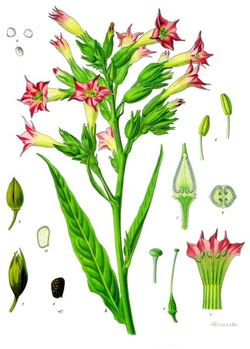Nicotiana (botany)
| Nicotiana (botany) | |
|---|---|
|
Drawing of N. tabacum |
|
| Taxonomical nomenclature | |
| Kingdom | Plantae |
| Unranked | Angiosperms |
| Unranked | Eudicots |
| Unranked | Asterids |
| Order | Solanales |
| Family | Solanaceae |
| Genus | Nicotiana |
| Species | tabacum & rustica |
| Common nomenclature | |
| Common names | Cig, fags, smoke, rollie, cancer stick, petùn, pieciétl |
| Constituents | |
| Active constituents | Nicotine |
Identification
Nicotiana tabacum is a robust annual little branched herb up to 2.5 m (8.2 ft) high with large green leaves and long trumpet-shaped white-pinkish flowers. All parts are sticky, covered with short viscid-glandular hairs, which exude a yellow secretion containing nicotine.
Leaves
Varied in size, the lower leaves are the largest at up to 60 cm (24 in) long, shortly stalked or unstalked, oblonged-elliptic, shortly acuminate at the apex, decurrent at the base, the following leaves decrease in size, the upper one sessile and smallest, oblong- lanceolate or elliptic.
Flowers
In terminal, many flowered inflorescences, the tube 5–6 cm (2.0–2.4 in) long, 5 mm (0.20 in) in diameter, expanded in the lower third (calyx) and upper third (throat), lobes broadly triangular, white-pinkish with pale violet or carmine colored tips tube yellowish white; calyx with five narrowly triangular lobes which are 1.5–2 cm (0.59–0.79 in) long. A capsular ovoid or ellipsoid, surrounded by the persistent calyx and with a short apical beak, about 2 cm (0.79 in) long. Seeds are very numerous, very small, ovoid or kidney shaped, brown.
Reproduction
Under basic conditions the very tiny seeds of N. Tabacum should remain viable for roughly 3-5 years (after which the germination rate falls drastically). They may remain viable for much longer if stored in an airtight container to be kept in a freezer, under such conditions seeds have sprouted after decades of storage. Their germination is activated by light, warmth, and moisture, as such they can be planted by simply sprinkling the seeds evenly over moist, fertile soil in a sunlit area, ideally after the last frost (or anytime if grown indoors at room temperature). If manually resupplying moisture be careful not to wash the small seed around, instead mist or water from beneath with a pan below the pot. Seeds kept warm will complete their germination in less than a week, though the process will take a few days longer at cooler temperatures.
Favorable growing conditions
N. Tabacum is a native of tropical and subtropical America but can be cultivated in many other regions given the proper conditions. Sunlight and temperatures of 20–30 °C (68–86 °F) are best for adequate growth; an atmospheric humidity of 80 to 85% and well drained soil rich in nitrogen and potash is also optimal. Farmed plants should be placed at least 2-3 feet apart, during a humid day to avoid them drying out. Once the plant is well established and rapidly growing it can be benificial to supply a feed rich in nitrogen and potash. The plant must be watered frequently as it can be prone to drying out. After 2-3 months in optimal conditions the plant will be ready for harvest.
Growth timeline
In optimal conditions seeds will germinate within a week and be ready for transplant outdoors or into individual containers. From there they require 2-3 months of good weather to mature into harvest-able plants. Blooms that become pollinated will form oblong pods that contain very small, densely packed seeds. These pods are mature once they've turned brown and can then be taken off the plant, and opened to reveal the seeds.
Active constituents
Every part of the plant except the seed contains nicotine, but the concentration is related to different factors such as species, type of land, culture and weather conditions. The concentration of nicotine increases with the age of the plant. Tobacco leaves contain 2 to 8% nicotine combined as malate or citrate. The distribution of the nicotine in the mature plant is widely variable: 64% of the total nicotine exists in the leaves, 18% in the stem, 13% in the root, and 5% in the flowers.
It also contains the following phytochemicals: anatabine, anabasine (an alkaloid similar to the nicotine but less active), glucosides (tabacinine, tabacine), 2,3,6-trimethyl-1,4-naphthoquinone, 2-methylquinone,2-napthylamine, propionic acid, anatalline, anthalin, anethole, acrolein, anatabine, cembrene, choline, nicotelline, nicotianine, and pyrene.
External links
References
This article does not cite enough references. You can help by adding some. |
